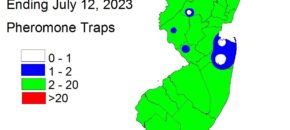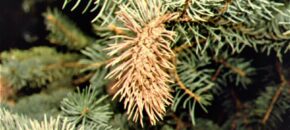There have been a few reports of Southern blight (Sclerotinia rolfsii) and White mold (Sclerotinia sclerotiorum) on tomato and pepper in New Jersey. Southern blight is much more common in vegetable areas south of the state where summer temperatures remain hotter (above 90°F) for longer periods of time. Like white mold, it can survive in […]
Continue reading...Vegetable IPM Update 7/12/23

Sweet Corn European corn borer (ECB) moth activity remains extremely low in areas where blacklight traps are operating in the northern and central counties. Feeding in whorl and pre-tassel stage corn has decreased over the past week. Many plantings exhibiting no ECB injury at all. While ECB has become something of a local phenomenon […]
Continue reading...Diagnosing Collar Rot and Alternaria Stem Rot of Tomato
Collar rot (Alternaria linariae) or Alternaria stem rot (Alternaria alternata f. sp. lycopersici) of tomato are common in young tomato plants. Either can be particularly troublesome in seedlings that have been held in transplant flats for an extended period of time before transplanting in hot, humid greenhouses. Collar rot infections often start where a leaflet branch has been […]
Continue reading...Landscape Pest Notes for July 2023

Cooley Spruce Gall Adelgid (1850-1950 GDD = galls open): Colorado spruce (especially green forms), Sitka and Oriental spruce, and Douglas-fir share this pest’s two host life cycles. Mature adult females lay eggs at the tips of branches. These eggs hatch and the immatures move to new growth and start feeding. The combined feeding and salivary […]
Continue reading...Controlling Phytophthora blight in cucurbit plantings
As the summer heats up in New Jersey, the control of Phytophthora blight in cucurbit plantings can be extremely difficult (even with the use of fungicides) as hot, wet weather finally sets in. Mitigating losses to Phytophthora blight in cucurbit crops begins with long crop rotations, where recommendations suggest crop rotations longer than 5 years […]
Continue reading...Diagnosing pith necrosis in tomato
Symptoms usually begin to appear on random plants throughout the field as green fruit begins to mature. The bacterium (Pseudomonas corrugata) is ubiquitous to soils and develops when weather conditions (cooler nights/very hot, humid days) and cultural practices (i.e., excess heavy N use) lead to favorable conditions for disease development. Symptoms include the development of […]
Continue reading...